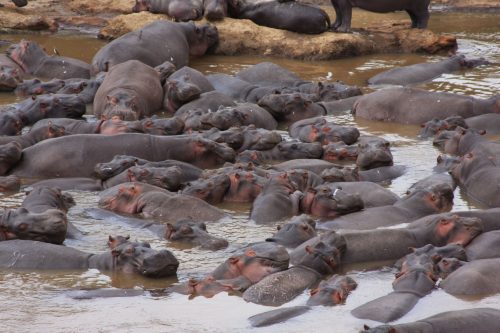Hippos may not be able to do math or solve complicated physics equations, but it turns out that they play a major role as engineers in the environment. A joint team of researchers from Yale University and the Cary Institute for Ecosystem Studies have focused on the downstream effects of organic matter produced by hippopotami on the Mara River for the past four years. They found that hippopotami waste causes drops in dissolved oxygen concentration levels in rivers, resulting in mass exterminations of resident fish in the streams, thus creating a significant impact on the ecosystem.
The researchers observed the Mara river over the span of three years. During this time, there were 55 flushing flows, events where hippo pools—pools full of hippo waste—are washed downstream, decreasing dissolved oxygen (DO) concentrations and potentially killing fish in the stream. Out of the 55 flushing flows, 49 had DO concentration drops by 0.04 to 5.5 milligrams per liter (mg/L).
“Most organisms need a certain amount of oxygen and when that oxygen concentration falls below 30% or generally 2mg/L, then those organisms can’t survive because metabolism shuts down,” said David Post, Yale Professor of Ecology and Evolutionary Biology and a researcher on the project. The typical DO levels in a river are around 6 to 8 mg/L. The most significant observed drop of 5.5 mg/L caused the DO concentration to fall to around 0.5-2.5 mg/L, which indicates a fish kill.
Next, the team of researchers investigated a possible correlation between hippo waste and drops in DO. The project occurred in three stages: small scale microcosm experiments, experimental streams, and whole ecosystem simulation. In the first stage, the scientists put hippo waste in bottles of water and measured dissolved oxygen over time. They observed that DO content decreased overtime. However, since the bottles of water were only representative of still water, the team decided to make experimental streams as they were more accurate to a moving river, allowing for reiterations and cycling of the water. In the experimental stream, there was a drop in DO levels and a subsequent recovery which occurred 8-12 hours into the experiment.
In the last portion of the study, the team constructed a dam and flushed a hippo pool downstream. Similar to the earlier experiments, DO levels at the beginning dropped significantly, but rose again in a matter of hours. To Post, the most surprising aspect of the results was their consistency. “It was quite surprising and reassuring that the results all tell the same story. It is not often that this happens in science.”
What shocked Dutton the most was the frequency of these flushing flows and the speed of the recovery. “If you didn’t measure the DO levels like we did throughout long periods of time, you wouldn’t even know this happened because in the span of 12 hours, the river is back to normal and the fish killed would all be eaten by scavengers so no trace would be left,” said Dutton.
The extent of the effects of flushing events have only been researched recently, but the repercussions on the environment are extensive. The Mara is an important area for tourism and sustaining the wildlife of the river is important. If these flushing flows significantly shift the food chain by killing the fish population, both the wildlife and the economy could suffer. On the other hand, fish kills could actually benefit the rest of the ecosystem by providing food for scavengers.
“The nutrients of the river could be put back into the ecosystem on land as the scavengers eat and defecate. This life and death process is happening everywhere and it is a fascinating system,” said Post.
Just as humans deposit waste into streams and rivers, degrading our ecosystem, animal waste can affect wildlife and habitats. However, this does not mean the waste humans produce is good for the environment. Post emphasizes that humans create long term oxygen depletion whereas animals like hippos only create periodic oxygen depletion. Essentially, human waste and animal waste have effects on different time scales. So, humans, don’t use this as an excuse the next time you drop trash into the ocean.

